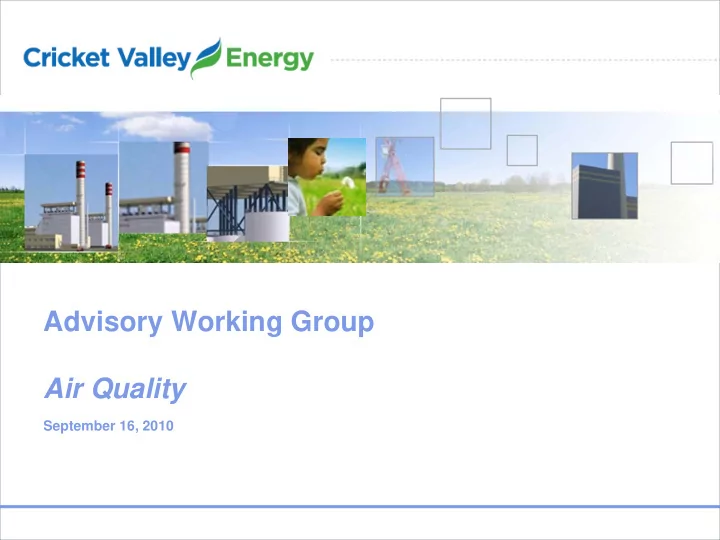

Advisory Working Group Air Quality September 16, 2010
Agenda � Introductions � Recap of 4/15 AWG meeting � New Air Quality Standards � “Dispatch” Analysis � Q&A � Next Meeting
Air Quality Advisory Group April 15 Meeting Recap � Reviewed CVE Air Permit Application (submitted March, 2010) which demonstrates: � Compliance with National Ambient Air Quality Standards (NAAQS) � Impacts on air quality are insignificant and protective of health even of the most vulnerable individuals � Impacts of non-criteria pollutants are well below all health-based guidelines � Contribution to acid rain resulting from air quality impacts is insignificant � Identified air monitoring locations � Discussed proposed continuous air monitoring systems � Set topics for next meeting
New USEPA Air Quality Standards � CVE’s permit submittal demonstrated compliance with USEPA standards in place as of March 2010 � In June 2010, USEPA issued a new ambient air quality standard for SO 2 and new requirements for demonstrating compliance with the new NO 2 standard that was issued in January 2010, shortly before CVE’s application was submitted � The two new, health-based, standards are: � 1-hour NO 2 Standard (100 ppb) � 1-hour SO 2 Standard (75 ppb)
How will CVE Respond to the New Standards? � CVE is completing additional analyses to demonstrate compliance with the new standards using the modeling guidance recently issued by USEPA � CVE will amend its application to demonstrate compliance with these two new requirements, further demonstrating its commitment to protect local air quality � CVE will also include the results of a Dispatch Analysis which quantifies regional air quality benefits that will accrue from the displacement of higher emitting units
Why is Dispatch Analysis Important? � The Scoping Document directs CVE to discuss the project’s purpose, public need, and benefits in its Draft Environmental Impact Statement � Public need and benefits are demonstrated through, among other things, a Dispatch Analysis, which shows how CVE will displace the operation of older, less efficient units, yielding economic and environmental benefits � Dispatch Analysis is required for a Certificate of Public Convenience and Necessity from the Public Service Commission (PSC) - the regulatory agency for electric and gas utilities
What is “Dispatch”? � New York State power is derived from various types/sources: � Types: Wind, Hydro, Nuclear, Other Renewables, Coal, Oil, Natural Gas � Outside Sources: ISO-New England, PJM (Pennsylvania, New Jersey, Maryland area), Ontario � Electric generators are “dispatched” by the NY Independent System Operator � Decisions on which energy resource to dispatch at any given time are made 24/7 from a control room near Albany � Fuel costs generally determine the order in which power plants are dispatched
What did the Dispatch Analysis Include? � Analyzed the entire New York electric grid � Included connections with ISO-New England, Pennsylvania Jersey Maryland (PJM) area and Ontario � Multi Area Production Simulation (MAPS) model simulated: � Operation of the grid, turning units on/off based on marginal cost � Historical diurnal, day of the week and seasonal patterns � Future load demand forecasts � Specific emissions data for each unit for CO 2 , NO x , and SO 2 . � Displacement of emissions by unit, grid and for the region
What did the Displacement Analysis Show? � In 2018, CVE operation would result in annual emissions reductions across New York, New England and PJM of: NO x – 1,612 tons SO 2 – 4,533 tons CO 2 – 716,818 tons � Each pinpoint represents an existing fossil fuel power plant
How Does this Affect My Air in Dover? � Air quality in Dover is dominated by regional, upwind sources as opposed to local sources. � Air quality modeling demonstrates CVE project contributions are insignificant with respect to health-based standards � Air quality modeling further demonstrates area air quality will continue to be dominated by regional emissions � CVE will displace: � 90 times as much SO 2 as it emits � 7 times as much NO x as it emit � 1.2 times as much CO 2 as it emits.
How we arrived at our results New York Independent System Operator - NYISO � Electricity is difficult to “store” so generation and consumption must always be equal � Amount of electricity generated must follow demand � NYISO “dispatches” power plants (turns on and off) to meet demand � Decision to “dispatch” is based primarily on the marginal cost of running each plant (fuel cost)
What Runs Our Grid? Regional Fuel Mix � New York and its neighbors (ISO-NE, PJM, Ontario) use a mix of fuels to generate electricity � Fuel costs determine the order in which power plants are dispatched � Environmental characteristics of the fuel affect the impact on air quality
How Are Power Plants Dispatched? 1. Wind and Hydro units No fuel cost; reliant on environmental conditions 2. Nuclear and (most) Coal units Very low fuel cost; difficult to “turn on and off” 3. Combined-Cycle Natural Gas units Natural gas plants are more efficient than oil plants and simple cycle plants Cricket Valley Energy will be among the first combined cycle plants dispatched, resulting in less frequent operation of existing older, less efficient units.
How Will CVE Reduce Emissions? � CVE is cleaner than older, less efficient plants � When CVE runs, it does so in place of a higher emitting alternative � This results in an air quality benefit that has been quantified through a dispatch analysis
Questions & Contacts Matthew Martin, Associate Project Manager 845-877-0596, mmartin@advancedpowerna.com 5 Market Street, Dover, NY 12522 Bob De Meyere, Project Manager 617-456-2214, bdemeyere@advancedpowerna.com 31 Milk Street, Suite 1001, Boston, MA 02109
Recommend
More recommend